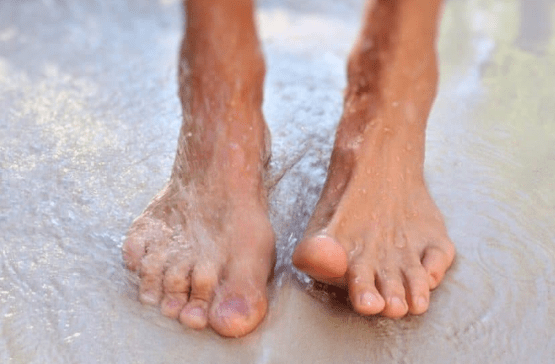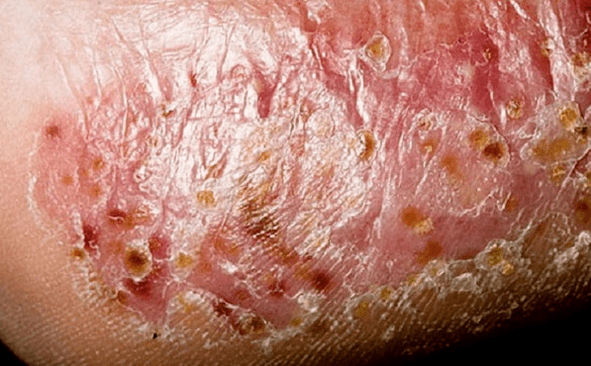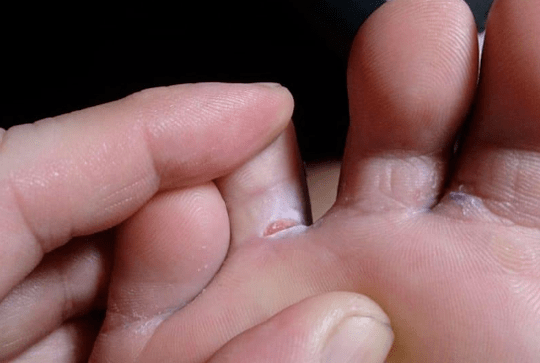It is a general name for infectious diseases that affects the person's feet, feet, or arms on the nails.In medicine, such pathologies are called mycosa - a whole group of diseases provoked by microscopic fungi.
Onychomycosis is distinguished - nail damage and dermatomycosis - localized on the skin of the legs.The disease is often an independent disorder, usually developing in the wake of disorders of various genesis.What are the fungi of the foot, the type of localization of the pathogen.

There are a large number of fungi, however, only some of them cause abnormal changes in humans.The microosis of the legs occupies the prevalence of the 2nd place among all skin diseases.The following groups of fungi are distinguished that are dangerous to health:
- Anthropophilic.Provoking pathologies only in humans, you can get infected from another person.
- Zooanthropophilic.They can also cause diseases in animals, infection from animals and other people.
- Candidate.Separate type of yeast fungi that has its own characteristics.
There are several types of pathology that have similar signs, which includes rubriomycosis and epidermophytosis.They are united by the general explanation of "Mikoza Stop".Symptoms of fungi on the legs are divided into type, but often they develop in parallel, so this difference is conditional.The following forms of pathology are distinguished:
- Scale;
- Interiginosny;
- Dyshydrose;
- Onychomycosis, which is divided into: normal, atrophic, hypertrophic.
The scientific name of the disease is onychomycosis.Infection affects the skin, mainly on the lower extremities, nail plates.Yeast and twigs fall on the exposed surface.
Foot fungus is a very common disease that humans have transmitted to the common use of objects.It is noteworthy that its distribution is very rapidly, and the development of the disease is concentrated in areas between the fingers.
Causes
Infection is directly in contact with fungi, which reproduces very quickly in the environment of warm and wet surfaces of the skin.It is possible to infect the foot fungi as a result of contact with its fungi on the human skin.
Situations in which fungi are transmitted through manicure and pedicure tools, as well as shoes and towels, are no exception.
Most often, the foot injury is among people who have problems with excess weight and blood circulation, and people with deformity of the legs are often subjected to it.Immune system disorders caused by unhealthy lifestyles, stress, antibiotics in the treatment of antibiotics, as well as improper nutrition, also determine the possibility of infection with leg fungi.
Wet skin, cracks, irritation, pathogenic and conditionally pathogenic fungi cause pathogenic and conditional.The types of fungi are as follows:
- The pathogenic species of fungi, when it enters the skin, causes the development of the inflammatory process, becomes fungal disease;
- Conditionally pathogenic microorganisms are constantly on the skin, and increased activity is manifested only by the action of provoking factors.
The source of infection is people with microosis.The pathogenic flora enters healthy skin in the accumulation of people.Comfortably different types of mushrooms develop under heat and high humidity.
Places of infection:
- Pools;
- Baths;
- Shutters rooms in sports centers;
- Public showers;
- Sauna;
- Fitness centers.

Important!Never go naked in common places.When you go to a sports club, in the pool, steam room, go through special shoes with you.
Some professions are in danger.The reason is the long presence of the legs in a closed, warm, humid environment.Fungal skin injuries often suffer:
- Miners;
- Athletes;
- Military;
- Hot shop workers.
Pay attention!Mycoses often develop in those who are obliged to wear closed shoes, regardless of whether they feel comfortable with their feet.Description of the work of many professions in the hot season even a special unit as a special unit.It is very difficult to fight mycosis under such conditions.
Other causes of fungal diseases:
- Bad hygiene of the legs;
- Skin trauma;
- Reduced immunity;
- Weapon shoes without nylon socks;
- Complications for diabetes.
Types and symptoms of foot fungi
There are many species of fungi.
The skin of the feet most often affects the following types:

- Red Trichophyte damages the legs and heels;
- Interdigital trichophyte is distributed in the inter -scoop zone, and in advanced cases affects the legs, the skin of the finger and the small finger of the epidermis;
- Trichophyte mentagrophytes - a type of fungal infection that develops in the skin on the human body (arms, inginous folds);
- Candida fungus - Infection causes candidiasis of mucous membranes and genitals, but there is also skin damage to the feet.
Dermatophyte can cause local skin damage.The name of such a disease of epidermophytosis is a very contagious pathology that develops extensively on the human body.
There are three forms of foot fungi:
- Interdaltic dermatophytosis in acute and chronic forms;
- Mochacino-Sicut;
- Vesicular, ulcerative.
The general symptoms of the disease are severe itching and burning, skin irritation, followed by particle skin.These are the signs that you can mostly see on the online online with which the internet is full.
Interdaltz dermatophytosis
What is this form?The most common, mainly between the 4th and 5th fingers of the localized leg.It is found in the form of cracks: in wet form, the skin looks swollen, and with a dry slice it will skin and collapse.
Often, along with interddalde dermatologists-fittings, other bacterial infections in the leg are awesome.The advanced form begins.Symptoms are enhanced, with unpleasant sensations - also, the patient feels severe pain that cannot get rid of.
Initial stage of interdigative form of fungi.
If the skin is cracked, blood can affect, which causes extra suffering.The psychological factor is coming - some people try to independently destroy the skin particles of the skin and it is not recommended to do so because a new infection is becoming.The disease is exacerbated.
The common name "Foot Athletes" refers to the feet of the fungus.It is quite difficult, caused by neglect of treatment, but it is easier to recognize.This pathology affects nail plates that begin to change color to black, green, blue or yellow.Transparency is lost, the nails are gradually deformed, poured and dissolved.
The leg rises at that moment, covering the pages on the sides.The leg becomes like macasine.
The disease is quite rare when compared to interdaltsevo and mochacino-Sicut.Blisters with muddy fluid are manifested on the entire surface of the leg.Over time, they ripen and glow.
The photo is presented in the ulcerative form of the foot fungi
Additional signs in patients are:
- Constant itching and burning;
- Peel, skin rises;
- Finger fingers that are also infected with fungi in contact with infected parts of the body;
- Swelling of the legs;
- Sometimes body temperature rises significantly.
Causes of the Disease of Disease
The source of the disease is a person with foot fungi whose skin particles are left on objects or in areas of community use.These can be baths, pools, locks of rooms and showers.Onychomycosis feels great with high humidity and is stable at low temperatures.
Most often, the causes of disease development are:

- Sanitation is in beauty salons when pedicure tools do not work or do it poorly;
- Use of someone else's items - towels, washing clothes, combs;
- Inadequate hygiene, sweating of the legs.
Failure of hygiene or excessive sweating of the legs causes focal fungi
But one contact with microorganisms-exchange is not enough.There are additional risk factors that exacerbate the situation and enhance, accelerate the development of the disease.
This includes:
- Foot and nail injuries, because when infected, the disease often transmits to the skin;
- Reduce immunity.As soon as this happens, the microorganisms begin to attack with revenge, making them more difficult to get rid of;
- HIV infection;
- Bad habits - alcoholism, smoking, excess smoking;
- Cardiovascular diseases, diabetes mellitus;
- Lower extremity lymphostasis.
Stages and their manifestations
The defeat of the legs with pathogenic flora microorganisms has several stages or the clinical form of its development on the skin:
- Echoes or starting stage;
- interdigital infection;
- Squamous-hycerkeratototot form;
- Dyshydrotic stage (wet fungi).
Folk remedies for the treatment of fungi
Folk methods of treatment can only be used as an auxiliary agent.As a major method of treatment for fungi, folk remedies are ineffective but can increase therapeutic effects of drugs.
First, baths are used.They have an antifungal effect and shine the skin, improving the penetration of ointments and solution components from fungi into deep layers of epidermis.Baths can be made according to the following recipes.
- Add 4 tablespoons vinegar to the basin and soak your feet for 15 minutes.
- Take two tablespoons of salt, soda and iodine solution with 4 liters of water.
- Add boric acid powder to the bath at 10 g speeds for 2 liters of water.
- Pour four tablespoons of tar soap into the basin with hot water, add half a cup of soda.
- In the bath, add 100 g of soda and one lemon juice with water.Fresh juice can be replaced with 10 drops of lemon essential oil.
Baths should be made daily throughout the treatment period.Their use is recommended before using an antifungal agent.You can use lotions with foot mushrooms.Propolis tincture helps to accelerate recovery.It should be evenly mixed with water, and then moisturized cotton spin in the resulting solution and treat the skin of the feet.
To date, there are many recipes for traditional medicine, the effectiveness of which is largely subject to some drugs.It should be noted that a positive result of alternative therapy can only be observed at the initial stage of development of fungal infection.The advanced form of mycosis is not subject to traditional medicine.
Traditional medicine medicines, like various medications, can be useless for the treatment of fungi on the feet.But, there are such efficacy for many centuries.
Tea tree essential oil is the best remedy that does not endanger the general health condition.Therefore, it can be safely used in pediatrics.Due to the presence of antiseptic action, the development of pathogenic fungi is blocked under its influence.
To prepare therapeutic ointments, mix aloe vera gel and tea tree oil in a 1: 3 ratio.This tool is cut twice a day in the affected areas.Such manipulations are recommended to be performed daily for three months.



























